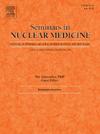New Promising Targets for Imaging in Cardiovascular Diseases
IF 5.9
2区 医学
Q1 RADIOLOGY, NUCLEAR MEDICINE & MEDICAL IMAGING
引用次数: 0
Abstract
Cardiovascular diseases (CVDs) remain the leading cause of morbidity and mortality worldwide, driven by complex and dynamic molecular processes such as inflammation, fibrosis, metabolic dysregulation, thrombosis, and vascular remodeling. While conventional imaging techniques provide valuable anatomical and functional information, they fail to capture these underlying pathophysiological mechanisms at the molecular level. Molecular imaging, particularly with PET and SPECT, offers the potential to noninvasively visualize and quantify these processes, enabling earlier diagnosis, better risk stratification, and more precise treatment guidance. Despite substantial progress in clinical cardiology, there is a growing need for novel radiotracers that can target key disease-driving mechanisms beyond traditional perfusion or viability imaging. Emerging radiopharmaceuticals now enable the assessment of myocardial fibrosis (e.g., collagen-targeted and MMP-targeted tracers), cardiomyocyte stress responses (e.g., oxidative stress, unfolded protein response, endothelin signaling), and metabolic alterations (e.g., fatty acid, ketone, and glucose metabolism). Additionally, new tracers are being developed for thrombosis, vascular inflammation, plaque instability, and even for innovative targets such as cellular senescence and gut-derived inflammatory pathways. These developments reflect a paradigm shift towards imaging-driven phenotyping of cardiovascular disease. This review provides a comprehensive overview of the latest advances in molecular imaging tracers for cardiovascular applications, with a focus on their biological rationale, preclinical and clinical evidence, and translational challenges. We categorize tracers by their mechanistic targets and highlight their potential for integration into precision cardiology.
心血管疾病成像的新靶点。
心血管疾病(cvd)仍然是世界范围内发病率和死亡率的主要原因,由复杂和动态的分子过程驱动,如炎症、纤维化、代谢失调、血栓形成和血管重塑。虽然传统的成像技术提供了有价值的解剖和功能信息,但它们无法在分子水平上捕获这些潜在的病理生理机制。分子成像,特别是PET和SPECT,提供了无创可视化和量化这些过程的潜力,使早期诊断,更好的风险分层和更精确的治疗指导成为可能。尽管临床心脏病学取得了实质性进展,但对新型放射性示踪剂的需求日益增长,这种示踪剂可以针对传统灌注或生存能力成像之外的关键疾病驱动机制。新兴的放射性药物现在能够评估心肌纤维化(例如,胶原靶向和mmp靶向示踪剂),心肌细胞应激反应(例如,氧化应激,未折叠蛋白反应,内皮素信号传导)和代谢改变(例如,脂肪酸,酮和葡萄糖代谢)。此外,新的示踪剂正在开发用于血栓形成、血管炎症、斑块不稳定,甚至用于创新靶点,如细胞衰老和肠道来源的炎症途径。这些发展反映了向成像驱动的心血管疾病表型的范式转变。本文综述了分子成像示踪剂在心血管应用方面的最新进展,重点介绍了分子成像示踪剂的生物学原理、临床前和临床证据以及转化挑战。我们将示踪剂按其机制靶点进行分类,并强调其整合到精确心脏病学中的潜力。
本文章由计算机程序翻译,如有差异,请以英文原文为准。
求助全文
约1分钟内获得全文
求助全文
来源期刊

Seminars in nuclear medicine
医学-核医学
CiteScore
9.80
自引率
6.10%
发文量
86
审稿时长
14 days
期刊介绍:
Seminars in Nuclear Medicine is the leading review journal in nuclear medicine. Each issue brings you expert reviews and commentary on a single topic as selected by the Editors. The journal contains extensive coverage of the field of nuclear medicine, including PET, SPECT, and other molecular imaging studies, and related imaging studies. Full-color illustrations are used throughout to highlight important findings. Seminars is included in PubMed/Medline, Thomson/ISI, and other major scientific indexes.
 求助内容:
求助内容: 应助结果提醒方式:
应助结果提醒方式:


